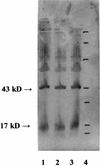Francisella tularensis bacteremia
- PMID: 12791928
- PMCID: PMC156490
- DOI: 10.1128/JCM.41.6.2774-2776.2003
Francisella tularensis bacteremia
Abstract
Bacteremia caused by Francisella tularensis is rare and has been reported mainly in the United States and infrequently in Europe. We report herein the first case of bacteremic F. tularensis pneumonia in an immunocompetent individual in southern Europe.
Figures


References
-
- Anda, P., J. S. Del Pozo, J. M. Diaz Garcia, R. Escudero, F. J. Garcia Pena, M. C. Lopez Velasco, R. E. Sellek, M. R. Jimenez Chillaron, L. P. Sanchez Serrano, and J. F. Martinez Navarro. 2001. Waterborne outbreak of tularemia associated with crayfish fishing. Emerg. Infect. Dis. 7(Suppl. 3):575-582. - PMC - PubMed
-
- Comité de l'Antibiogramme de la Société Française de Microbiologie. 2002. Communiqué 2002. Société Française de Microbiologie, Paris, France.
-
- Dennis, D. T., T. V. Inglesby, D. A. Henderson, J. G. Bartlett, M. S. Ascher, E. Eitzen, A. D. Fine, A. M. Friedlander, J. Hauer, M. Layton, S. R. Lillibridge, J. E. McDade, M. T. Osterholm, T. O'Toole, G. Parker, T. M. Perl, P. K. Russel, and K. Thonat. 2001. Tularemia as a biological weapon. Medical and public health management. JAMA 285:2763-2773. - PubMed
-
- Doern, G. V. 2000. Detection of selected fastidious bacteria. Clin. Infect. Dis. 30:166-173. - PubMed
Publication types
MeSH terms
LinkOut - more resources
Full Text Sources

